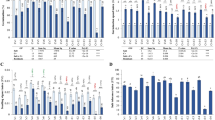Summary
A collection (5,072 lines) of wheat germplasm was screened at the seedling stage for tolerance to salinity concentrations having electrical conductivities of 0.8 (control), 12.5, 18.75 and 25.0 dS/m. Surviving seedlings were expressed for each line as a percentage of the control value. The 442 lines with greater than 70% surviving seedlings were tested for whole-life cycle survival under each salinity condition. The data of the reactions to salinity at both the seedling stage and maturity were used to classify the collection according to: (1) country of origin (2) species and ploidy level. The data were then subjected to a diversity analysis using the Shannon-Weaver information index. Seedling stage tolerance to 12.5 dS/cm salinity was widely distributed in the collection (79% of lines), whereas only 9% were tolerant at 25.0 dS/m salinity. The seedling stage tolerance was indicative of maturity tolerance. At the seedling stage, entries from USA and Egypt showed the largest proportions of tolerant lines. In addition, USA, Mexico and Egypt entries exhibited the widest variability. Diversity among regions was greater than among countries within regions, while the diversity among species was greater than among ploidy levels. Tetraploids exceeded hexaploids and diploids in the proportion of tolerant lines and diversity. Wheat-rye derivatives showed a good potential for salt tolerance at early stages. Screening more germplasm from the arid and semi-arid regions especially from countries with salt affected soils was recommended.
Similar content being viewed by others
References
Allard RW (1970) Population structure and sampling methods. In: Frankel OH, Bennett E (eds) Genetic resources in plants — their exploration and conservation. IBP no 11. Blackwell, Oxford Edinburgh, pp 79–107
Bennett E (1970) Tactics in plant exploration. In: Frankel OH, Bennett E (eds) Genetic resources in plants — their exploration and conservation. IBP no 11. Blackwell, Oxford Edinburgh, pp 157–170
Elgabaly MM, Gweaifel IM, Hassan MN, Rosanov BG (1969) Soil map and land resources of UAR. Res Bull 22, Institute Land Reclamation, University of Alexandria, Egypt
Epstein E, Norlyn JD (1977) Sea based crop production: a feasibility study. Science 179:249–251
Epstein E, Kingsbury RW, Norlyn JD, Rush DW (1979) Production of food crops and other biomass by seawater culture. In: Hollander A (ed) The biosaline concept. An approach to utilisation. Plenum Press, New York
Holcomb JD, Tolbert DM, Jain SK (1977) A diversity analysis of genetic resources in rice. Euphytica 26:441–450
Hondelmann W (1979) Wheat germplasm collection, conservation and utilisation through international cooperation. In: Ramanujam S (ed) Proc 5th Int Wheat Genet Symp, Ind Soc Genet Plant Breed, New Delhi, pp 149–155
Jain SK, Qualset CO, Bhatt GM, Wu KK (1975) Geographical patterns of phenotypic diversity in world collection of durum wheats. Crop Sci 15:700–704
Jain SK, Wu KK (1977) A note on germplasm diversity in the world collections of safflower. Econ Bot 31:72–75
Marshall DR, Brown AHD (1975) Optimum sampling strategies in genetic conservation. In: Frankel OH, Hawkes JG (eds) Crop genetic resources for today and tomorrow. Cambridge University Press, Cambridge, pp 58–80
Moseman JG, Kilpatrick RA, Porter WM (1979) Evaluation and documentation of pest resistance in wheat germplasm collections. In: Ramanujam S (ed) Proc 5th Int Wheat Genet Symp, Ind Soc Genet Plant Breed, New Delhi, pp 143–149
Norlyn JD (1980) Breeding salt tolerant plants. In: Genetic engineering of osmoregulation: impact on plant productivity for food, chemicals and energy. Plenum Press, New York, pp 58–80
Pielou EC (1969) An introduction to mathematical ecology. Wiley and Sons, New York
Richards LA (1954) Diagnosis and improvement of saline and alkali soils. US Dept Agric, Handbook No 60
Rick CM (1972) Potential genetic resources in tomato species: clues from observations in native habitats. In: Srb AM (ed) Genes, enzymes and populations. Plenum Press, New York, pp 255–269
Rush DW, Epstein E (1976) Genotypic responses to salinity: differences between salt-sensitive and salt tolerant genotypes of the tomato. Plant Physiol 57:162–166
Sayed HI, Mashhady AS, Abdul-Aziz MH (1984) Screening for salinity tolerance in wheat. In: Proc 6th Int Wheat Genet Symp. Kyoto, Japan, pp 383–387
Shannon MC (1978) Testing salt tolerance variability among tall wheat-grass lines. Agron J 70:719–722
Shannon MC, Wheeler EL, Saunder RM (1981) Salt tolerance of Australian channel millet. Agron J 73:830–832
Steila D (1976) The geography of soils, formation, distribution and management. Prentice Hall, Englewood Cliffs, New Jersey
Tolbert DM, Qualset CO, Jain SK, Craddock JC (1979) A diversity analysis of a world collection of barley. Crop Sci 19:789–794
Author information
Authors and Affiliations
Additional information
Communicated by A. L. Kahler
Contribution of Project (AR-1-73) SANCST
Rights and permissions
About this article
Cite this article
Sayed, H.I. Diversity of salt tolerance in a germplasm collection of wheat (Triticum spp.). Theoret. Appl. Genetics 69, 651–657 (1985). https://doi.org/10.1007/BF00251118
Accepted:
Issue Date:
DOI: https://doi.org/10.1007/BF00251118




